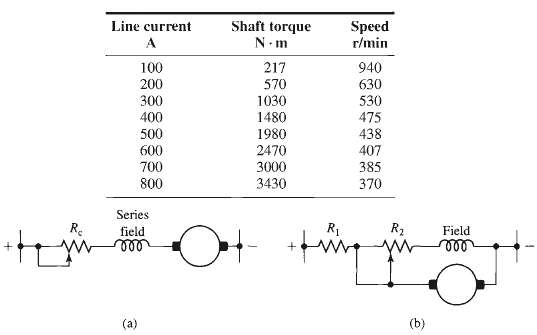A common industrial application of dc series motors is in crane and hoist drives. This problem relates
Question:
A common industrial application of dc series motors is in crane and hoist drives. This problem relates to the computation of selected motor performance characteristics for such a drive. The specific motor concerned is a series-wound, 230-V, totally-enclosed motor having a 1/2-hour crane rating of 100 kW with a 75°C temperature rise. The performance characteristics of the motor alone at 230 V as found in the manufacturer's catalog are listed in Table. The resistance of the armature (including brushes) plus commutating winding is 0.065? and that of the series field winding is 0.027?. Armature reaction effects can be ignored. The motor is to be connected as in Figure a for hoisting and Figure b for lowering. The former connection consists simply of series-resistance control. The latter connection provides dynamic breaking with the field reconnected in shunt with the addition of an adjustable series resistance. You will use MATLAB to plot some sample speed torque curves (speed as a function of torque) to determine the suitability of the motor and control for the specified application. Plot all of the curves on a single set of axes coveting roughly the torque magnitude range found in Table. Provide for both positive and negative values of speed, corresponding respectively to hoisting and lowering, as well as for both positive and negative values of torque, corresponding respectively to torque in the direction of raising the load and torque in the direction of lowering the load.
a. For the hoisting connection, plot speed-torque curves for the control resistor R c set at 0, 0.3 and 0.6?. If any of these curves extend into the fourth quadrant within the range of torques covered, interpret physically what operation in that regime means.
b. For the lowering connection, plot a speed-torque curve for R1 = 0.3? and R2 = 0.3?. The most important portion of this curve is in the fourth quadrant, but if it extends into the third quadrant, that region should also be plotted and interpreted physically.
c. In part (b), what is the lowering speed corresponding to a torque of 1500 N ??? m?

Step by Step Answer:






